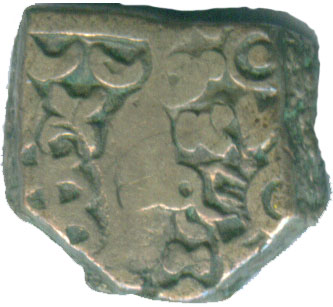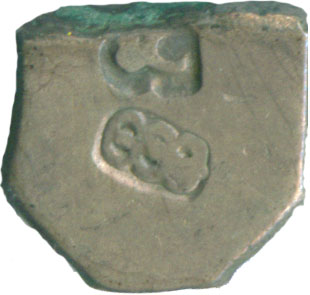| SPECIFICATIONS | |
| Alloy | Silver |
| Type | Struck |
| Height | 12.2 mm |
| Width | 13.6 mm |
| Thickness | 2.7 mm |
| Weight | 3.07 gms |
| Shape | Pentagon |


|

|

| ||||||||||||||||
| OBRW G.82; G&H #567 | ||||||||||||||||||
These punch-mark coins (PMC) are cataloged with classification proposed by P. L. Gupta and T. R. Hardaker (1985) in Indian Silver Punched-marked Coins: Magadha-marura Karshapara Series, Nasik, as G&H #567, which is listed as an Normal abundance type.
Punch-marked coins from a single hoard of 28 Imperial Punched-marked and 4 Lakshmi plaques found in a Terracotta money box (I.1) found in Akurugodella are illustrated in the 1999 catalog Ruhuna. An Ancient Civilization Re-visited by Bopearachchi and Wickramasinhe (OBRW), G.59-G.86 Plates 9-11. This coin is Plate Specimens G.82 in this book. Click here for longer discussion and links to other Plate Specimens from this book in this collection.
Text from
* Ceylon Coins and Currency By H. W. Codrington. Colombo 1924
Page 16 Chapter III Ancient Coins - Edlings - Plate 1
The coin was scanned at 600 dpi and is displayed at 400 dpi.
This coin ex: Raja Wickramasinghe, is from part of Lalith Raddella's
collection I purchased in 2016 December.